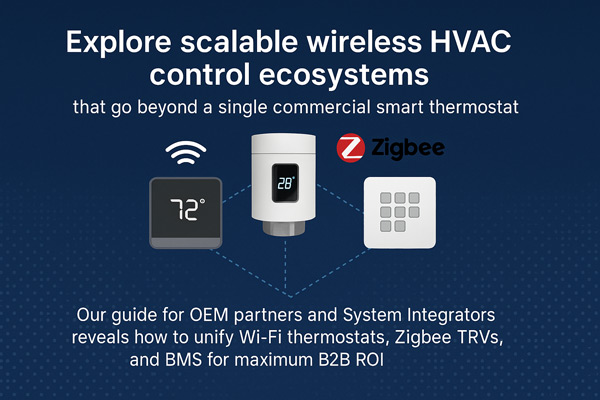Introduction: The Fragmented Commercial HVAC Problem
For property managers, system integrators, and HVAC equipment manufacturers, commercial building temperature management often means juggling multiple disconnected systems: central heating, zone-based AC, and individual radiator control. This fragmentation leads to operational inefficiencies, high energy consumption, and complex maintenance.
The real question isn’t which commercial smart thermostat to install—it’s how to unify all HVAC components into a single, intelligent, and scalable ecosystem. In this guide, we explore how integrated wireless technology, open APIs, and OEM-ready hardware are redefining commercial building climate control.
Part 1: The Limitations of Standalone Commercial Smart Thermostats
While Wi-Fi smart thermostats offer remote control and scheduling, they often function in isolation. In multi-zone buildings, this means:
- No holistic energy visibility across heating, cooling, and radiator subsystems.
- Incompatible protocols between HVAC equipment, leading to integration bottlenecks.
- Costly retrofitting when expanding or upgrading building management systems.
For B2B clients, these limitations translate into missed savings, operational complexity, and lost opportunities for automation.
Part 2: The Power of an Integrated Wireless HVAC Ecosystem
True efficiency comes from uniting all temperature control devices under one intelligent network. Here’s how a unified system works:
1. Central Command with Wi-Fi and Zigbee Thermostats
Devices like the PCT513 Wi-Fi Thermostat serve as the primary interface for building-wide HVAC management, offering:
- Compatibility with 24V AC systems (common in North America and Mid-East markets).
- Multi-zone scheduling and real-time energy usage tracking.
- MQTT API support for direct integration into BMS or third-party platforms.
2. Room-Level Precision with Zigbee Thermostatic Radiator Valves (TRVs)
For buildings with hydronic or radiator heating, Zigbee TRVs like the TRV527 deliver granular control:
- Individual room temperature tuning via Zigbee 3.0 communication.
- Open Window Detection and Eco Mode to prevent energy waste.
- Interoperability with OWON gateways for large-scale deployment.
3. Seamless HVAC-R Integration with Wireless Gateways
Gateways such as the SEG-X5 act as the communication hub, enabling:
- Local (offline) automation between thermostats, TRVs, and sensors.
- Cloud-to-cloud or on-premise deployment via MQTT Gateway API.
- Scalable device networks—supporting everything from hotels to apartment complexes.
Part 3: Key Selection Criteria for Integrated HVAC Solutions
When evaluating ecosystem partners, prioritize suppliers who offer:
| Criteria | Why It Matters for B2B | OWON’s Approach |
|---|---|---|
| Open API Architecture | Enables custom integration with existing BMS or energy platforms. | Full MQTT API suite at device, gateway, and cloud levels. |
| Multi-Protocol Support | Ensures compatibility with diverse HVAC equipment and sensors. | Zigbee 3.0, Wi-Fi, and LTE/4G connectivity across devices. |
| OEM/ODM Flexibility | Allows branding and hardware customization for wholesale or white-label projects. | Proven experience in OEM thermostat customization for global clients. |
| Wireless Retrofit Capability | Reduces installation time and cost in existing buildings. | Clip-on CT sensors, battery-operated TRVs, and DIY-friendly gateways. |
Part 4: Real-World Applications – Case Study Snippets
Case 1: Hotel Chain Implements Zonal HVAC Control
A European resort group used OWON’s PCT504 Fan Coil Thermostats and TRV527 Radiator Valves to create per-room climate zones. By integrating these devices with their property management system via OWON’s Gateway API, they achieved:
- 22% reduction in heating costs during off-peak seasons.
- Automated room shutdown when guests checked out.
- Centralized monitoring across 300+ rooms.
Case 2: HVAC Manufacturer Launches Smart Thermostat Line
An equipment manufacturer partnered with OWON’s ODM team to develop a dual-fuel smart thermostat for the North American market. The collaboration included:
- Custom firmware for heat pump and furnace switching logic.
- Hardware modifications to support humidifier/dehumidifier controls.
- White-label mobile app and cloud dashboard.
Part 5: ROI and Long-Term Value of an Integrated System
An ecosystem approach to HVAC control delivers compounding returns:
- Energy Savings: Zone-based automation reduces waste in unoccupied areas.
- Operational Efficiency: Remote diagnostics and alerts cut maintenance visits.
- Scalability: Wireless networks simplify expansion or reconfiguration.
- Data Insights: Centralized reporting supports ESG compliance and utility incentives.
Part 6: Why Partner with OWON?
OWON isn’t just a thermostat supplier—we’re an IoT solution provider with deep expertise in:
- Hardware Design: 20+ years of electronic OEM/ODM experience.
- System Integration: End-to-end platform support via EdgeEco®.
- Customization: Tailored devices for B2B projects, from firmware to form factor.
Whether you’re a system integrator designing a smart building stack or an HVAC manufacturer expanding your product line, we provide the tools and technology to bring your vision to life.
Conclusion: From Standalone Devices to Connected Ecosystems
The future of commercial HVAC lies not in individual thermostats, but in flexible, API-driven ecosystems. By choosing partners who prioritize interoperability, customization, and deployment simplicity, you can transform building climate control from a cost center into a strategic advantage.
Ready to build your unified HVAC ecosystem?
[Contact OWON’s Solutions Team] to discuss integration APIs, OEM partnerships, or custom device development. Let’s engineer the future of intelligent buildings, together.
Post time: Nov-24-2025
